 |
 |
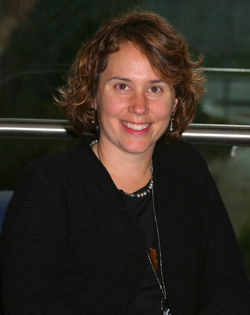
|
|
Megan Robb, Art Therapist, Clinical Research Center, National Institutes of Health, Bethesda, MD
|
Art TherapistMeet a real Art Therapist, Megan Robb
1. I chose this career because...
2. My typical workday involves...
3. What I like best/least about my work...
4. My career goals are...
5. When I'm not working, I like to...
|
|
1. I chose this career because...
|
Back to Top

|
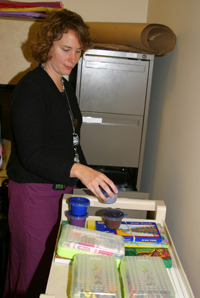
|
|
Megan gathers art supplies for bedside therapies.
|
I chose to become an art therapist because of both of my interests in art and community outreach. I have always enjoyed making art, but never felt that my artistic skills were strong enough to pursue a career in graphic arts. My volunteer work helped me find a way to use art in a very positive way.
For one of my first jobs in high school, I worked with children fostering social skills such as conflict resolution, self-advocacy, and self-esteem. It was a community outreach program with the local children’s museum. We went to low-income neighborhoods and provided arts, crafts and recreational activities while teaching confliction resolution skills. We also did other fun and practical workshops such as Bike Repair. To work there, I did an orientation where they taught basic skills for the job. New employees could develop the skills further while on the job. While in college, I continued working there during summer breaks and slowly took on opportunities to manage staff and run the program.
I chose a college that had a variety of majors because I was still not sure what career path to follow after high school. Some of the majors that interested me included early childhood education, art, and psychology. Towards the end of my college education, I had finished enough courses to have a major in art and a minor in psychology.
Searching for an Ideal
After receiving my degree, I worked a few jobs but did not find the right one. I moved to Boston in hopes of finding a job in community development. At that time, I had an idealist view about community work. I was influenced by the books of a famous Harvard psychiatrist, Robert Coles, in particular, his book entitled, “The Call of Service,” http://www.amazon.com/Call-Service-Robert-Coles/dp/0395710847/sr=1-15/qid=1161181028/ref=sr_1_15/104-6820804-0464728?ie=UTF8&s=books. While searching for employment, I quickly realized that many employers were looking for bilingual people, especially those fluent in the Asian languages. Since I did not have that skill, I took a job as a bartender to cover my living expenses. The job helped me earn a living, but I was not fulfilled and I still hoped to do community work.
One evening, while driving home from work, I was feeling especially frustrated with my career. I knew I wanted something else. When I got home that same evening, I received a letter in the mail with a job offer to coordinate and manage a community-based speakers bureau sponsored by a non-profit organization called The Heart of America Foundation http://www.heartofamerica.org/index.htm. This organization gave me an award for the community volunteer work I did while in high school. It was perfect timing. I accepted the job and moved to the Washington DC. area.
After working in the position for a while, I decided to pursue a master’s degree in art therapy.
Though other people warned of the career’s moderate income potential, I was not deterred. The field provided a platform to use my skills of helping people through a creative outlet. So far, I have been able to provide for my family and do a job that I love!
College Education
- Bachelor of Arts, Studio Arts, Psychology minor, Truman State University, Kirksville, Missouri
- Master’s Degree, Art Therapy, George Washington University, Washington, D.C.
Certification
In art therapy, the first step is to complete your art therapy registration (ATR) by fulfilling 1000 hours of supervised work as an art therapist. The highest competency for art therapy is passing the national art therapy board exam to receive your (ATR-BC).
Since neither of those competencies fulfills state requirements, I pursued becoming a Licensed Professional Counselor (LPC) in the District of Columbia by passing the National Counseling Exam.
|
|
2. My typical workday involves...
|
Back to Top

|
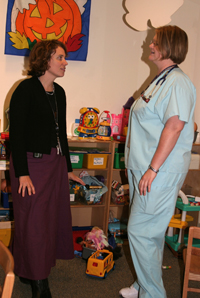
|
|
Megan discusses a case schedule with one of her colleagues in the NIH Clinical Center.
|
My typical workday is from 8:00 am until 4:30 pm. Each day is filled with seeing patients, both in group therapy settings, and individually by the bedside. I provide therapy for patients undergoing medical and psychiatric research protocols at NIH including treatment for alcoholism, schizophrenia, mood disorders such as depression or bi-polar disorder, and medical conditions including chronic illnesses or rare diseases. Patients range from children to the elderly, and are both inpatients and outpatients.
I work with doctors, nurses, and other therapists to provide therapeutic art opportunities appropriate to each patient. Art therapy is the process, not the final product. Common practices I use include:
- Drawing or painting
- Sculpture
- Art using various materials & multiple mediums
- Sewing and working with fabric
- Making masks
I see patients for different reasons. Frequently doctors or nurses request consultations with their patients. At other times, I recognize when a family is struggling and provide family therapy when one member is a patient at the NIH. I meet with them as family group and on an individual basis when necessary. For example, I may work with the adult provider who carries the weight of decisions regarding care of a family member. In some cases, I see patients as part of the pain and palliative team we have at the clinical center. The therapy aims to help people deal with chronic illness and pain. Therapy for pain management might use guided imagery to help patients see the pain as something tangible. They can draw a picture and I “take it away” with me to symbolize taking the pain away from them. We visit all the units and make sure other staff members are aware of the services we provide.
Group Therapy Vs. Individual Therapy
Some units will request group therapy, for example the unit treating alcoholism. It is a very structured unit where patient’s days are tightly scheduled. Group therapy has the advantage that it helps patients feel that they are not going through it alone. They benefit from the mutual support and feedback from their peers. I come to the group with a directive, which is often a behavioral goal to work towards. People with alcoholism, for example, forget how to connect to their feelings because they are used to numbing those feelings with alcohol. I may ask them to create a picture reflecting moments in their life when they felt in control. Then I ask that they think about moments in life when they did not feel in control, and to create a picture. I try to match the art materials to the process. They may use watercolors (a medium they may feel less able to manipulate or control) to express loss of control. Markers or colored pencils may be used to express feelings of being in control.
Individual therapy is often used for patients with a strong history of trauma or abuse, with a strong need for attention, or who show the ability and inclination for gaining self-awareness. Individual therapy is also good for patients on medical protocols, for pain management, and for those dealing with end-of-life issues.
|
|
3. What I like best/least about my work...
|
Back to Top

|
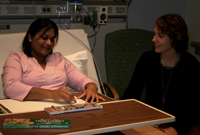
|
|
Megan has an art therapy session with a patient.
|
What I like best about my work is seeing a patient experience an “aha” moment, which is when one gains self-awareness. I also like the day-to-day contact with people from a variety of backgrounds. In several of my previous positions, I worked with emotionally disturbed children in a school setting, adults and children in a psychiatric hospital, and children in an oncology unit. Since I started working here at NIH, I enjoy the challenging work with the diversity of the patients’ medical and mental conditions.
What I like least about my work is dealing with end of life issues. After getting to know the patients and families, it can be tough going through those times with them.
|
|
4. My career goals are...
|
Back to Top

|
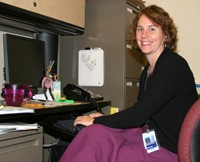
|
|
Megan catches up on paperwork at her desk.
|
My career goals are to continue to hone my therapeutic skills, publish again and present on the theoretical framework of art therapy within NIH. I have been working as a therapist for about 5 years, with experience in different stages of recovery, with different types of cases. I believe that with more time and experience gained, I will learn what works best, and become a better therapist.
I previously published a professional paper in the American Art Therapy Journal about a case study I did with Russian orphans. I hope to publish more work in the future.
People practice art therapy in different ways. It runs the gamut from very clinically-based to very community-based. I’m proposing to do an art therapy program that will promote community building. If successful, I hope to present the program at the national conference of the American Art Therapy Association.
|
|
5. When I'm not working, I like to...
|
Back to Top

|
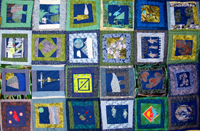
|
|
Shown is a quilt completed by patients and staff as a symbol of the collaborative efforts on the unit.
|
When I’m not working, I like to spend time with my husband listening to live folk and blues music and zydeco (folk-type) dancing or reading books. I also enjoy family time with our infant son who is learning new tricks every day. I wish I had more time to play with making art though!
|
|
|
|
 |